Asian Student Files Reverse Discrimination Complaint Against Princeton University: Outcome of Litigation Could Undercut Affirmative Action Programs Benefiting Blacks
 Jian Li, a Chinese-American student, graduated in the top one percent of his class at a public high school in New Jersey. He received a perfect score of 2400 on the SAT and a combined near-perfect 2390 on three SAT-II subject tests. Yet he was rejected for admission to Princeton University. A white student from the same high school who finished lower in the class rankings and had lower scores on standardized tests was admitted to Princeton. Jian Li, a Chinese-American student, graduated in the top one percent of his class at a public high school in New Jersey. He received a perfect score of 2400 on the SAT and a combined near-perfect 2390 on three SAT-II subject tests. Yet he was rejected for admission to Princeton University. A white student from the same high school who finished lower in the class rankings and had lower scores on standardized tests was admitted to Princeton.
Li filed a formal complaint against Princeton with the Office for Civil Rights of the U.S. Department of Education. The federal government is now investigating the case.
Asians are currently 13.1 percent of the student body at Princeton, a higher rate than the Asian-American population of the United States but similar to the Asian student population at Harvard and Yale. There is a larger percentage of Asian students at a number of other elite universities. At MIT, Asians are more than 26 percent of the student body. At Berkeley, the percentage of Asians in the student body is now 42 percent. A decade ago, when race could be considered as a factor in admissions decisions at Berkeley, Asians were probably harmed because there were powerful efforts at Berkeley to recruit blacks. At that time 34 percent of all students at Berkeley were Asian.
The case raises an issue very similar to that facing elite schools in the 1920s, what the president of Harvard University at that time called the “Hebrew invasion.” Jewish students who sought admission to Harvard, Yale, and Princeton were better qualified than any other racial group and the Ivy League schools particularly began to discriminate against them for fear that these institutions would become predominantly Jewish.
If the courts should rule that Asian students are being illegally held to a higher, and constitutionally forbidden, standard of admission, the percentage of Asian students at the highly selective schools will rise in detriment to black Americans. Asian students' mean SAT scores are over 225 points, or about 20 percent, higher than the mean scores of blacks.
  |
“Asian-American children have excellent grades and scores but are being rejected by the most selective colleges. It appears to be an open secret.”
— Don Joe, founder of the Internet site Asian-American Politics, commenting on a reverse discrimination complaint filed by an Asian student who was rejected for admission by Princeton University, in The Wall Street Journal, 11-11-06 (See story above.)
|
Federal Funding for Program to Boost Number of Black Medical Students Is About to Run Out
 The Center of Excellence program was established by Congress in 1987 to help medical schools recruit and retain students from underrepresented minority groups. The Association of American Medical Colleges reports that tens of thousands of black and other minority students have participated in the program over the past two decades. Yet blacks are still only 3 percent of all physicians in this country. The Center of Excellence program was established by Congress in 1987 to help medical schools recruit and retain students from underrepresented minority groups. The Association of American Medical Colleges reports that tens of thousands of black and other minority students have participated in the program over the past two decades. Yet blacks are still only 3 percent of all physicians in this country.
In 2004 the U.S. Congress appropriated $33.3 million in grants to 34 medical schools under the Center of Excellence program. Last year the program’s budget was slashed to $11.8 billion. In the current fiscal year, there are no funds whatsoever for the program.
Some medical schools are seeking other funding sources to keep alive their Center of Excellence programs. Also, it is hoped that the new Congress, under Democratic leadership, will restore funding.

Interdenominational Theological Center

Womanist Scholars Fellowship
The Womanist Scholars Program, a component of the Black Women in Church and Society Program (Jacquelyn Grant, PhD, Director) at the Interdenominational Theological Center in Atlanta, Georgia, provides affirming, creative and intellectual opportunities for womanist scholars to engage in scholarship. This appointment is given annually to two Visiting Scholars who have done significant research on issues concerning Black women, religion and spirituality. The Womanist Scholars Program is designed to assist Black women scholars seeking sabbatical or independent support for a specific research project. Requirements include one academic year in residence along with teaching (one course), (one public) lecture, research and writing for publication. It awards a $37,500 fellowship.
Applicants must submit: a completed application form; research prospectus (not to exceed four typed pages) outlining the intended research project with the proposed methodology and the project’s significance for the academic, religious and larger communities; one page narrative describing your philosophy of and commitment to womanist scholarship; a course proposal; writing sample (published or unpublished); current curriculum vitae and three letters of reference.
For information, contact Marion R. Pierre, Program Administrator, ITC-BWCS, 700 Martin Luther King, Jr. Dr. SW, Atlanta, Georgia 30314. Call 404-527-5713 or email mpierre@itc.edu, www.itc.edu/pages/wsp/WSPHome.htm.
The application and all supporting materials must be postmarked by December 8, 2006.

Enrollment Trends at the Nation’s Black Colleges
Total enrollments at the nation’s historically black colleges and universities stood at 303,512 in 2003. This was up 8.3 percent over the previous decade.
There were 245,494 African Americans enrolled at black colleges in 2003. Therefore, blacks were about 81 percent of the total enrollments at these colleges and universities.
Black enrollments at HBCUs were up 7.9 percent over the 1993 to 2003 period. Hispanic enrollments at black colleges were up 57 percent. But Hispanics were only 2.5 percent of all students at the black colleges. There are five times as many white students at the black colleges than there are students of Hispanic ethnicity.
Professor at London School of Economics Publishes Paper Alleging Low Levels of Intelligence Are Responsible for Chronic Health Problems in Africa
 Satoshi Kanazawa, an evolutionary psychologist at the London School of Economics, recently published an article in the British Journal of Health Psychology which analyzes health indicators in 126 nations around the world. The paper then correlates these health indicators with data on average IQ ratios in those countries. Professor Kanazawa reaches the highly inflammatory conclusion that the African states suffer from high rates of poverty and chronic health problems because their populations are on average less intelligent than people in countries on other continents. Satoshi Kanazawa, an evolutionary psychologist at the London School of Economics, recently published an article in the British Journal of Health Psychology which analyzes health indicators in 126 nations around the world. The paper then correlates these health indicators with data on average IQ ratios in those countries. Professor Kanazawa reaches the highly inflammatory conclusion that the African states suffer from high rates of poverty and chronic health problems because their populations are on average less intelligent than people in countries on other continents.
Professor Kanazawa reports statistics which put Ethiopia’s average IQ at 63, the lowest in the world. He adds that life expectancy for both men and women in Ethiopia is around 40 years, among the lowest in the world.
As might be expected, Professor Kanazawa’s article has created an uproar on the London School of Economics campus. Black student groups claim that the professor is revisiting discredited theories of eugenics. The administration of the school released a statement which said, “This is academic research based on empirical data and published in a peer-reviewed journal. The school does not take any institutional view on the work of individual academics.”
Obviously the paper will face severe attack by professionals who will assert that the low “measured” IQ of Ethiopians has to do with educational and social factors and not inherent genetic differences.
  |
90.1% Percentage of all white adults in the U.S. over the age of 25 in 2005 who had completed high school.
81.1% Percentage of all African-American adults in the U.S. over the age of 25 in 2005 who had completed high school.
source: U.S. Census Bureau
|
Hampton University Establishes a New Ph.D. Program
 Hampton University, the historically black educational institution in Virginia, has gained approval for a new Ph.D. program in atmospheric and planetary sciences. It is the only historically black university to offer a Ph.D. program in this field. The new department of atmospheric and planetary sciences will include the existing Center for Atmospheric Science. The new department will be chaired by Professor Bill Paterson. Hampton University, the historically black educational institution in Virginia, has gained approval for a new Ph.D. program in atmospheric and planetary sciences. It is the only historically black university to offer a Ph.D. program in this field. The new department of atmospheric and planetary sciences will include the existing Center for Atmospheric Science. The new department will be chaired by Professor Bill Paterson.
University of Colorado Mounts Unique Recruitment Effort for Black Students
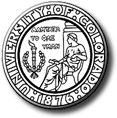 In the past several years the University of Colorado at Boulder has experienced a number of racial incidents on campus. University officials have made a concerted effort to recruit black students to combat the negative publicity surrounding these events. These efforts appear to be making a difference as black first-year enrollments at the university have increased this year. In the past several years the University of Colorado at Boulder has experienced a number of racial incidents on campus. University officials have made a concerted effort to recruit black students to combat the negative publicity surrounding these events. These efforts appear to be making a difference as black first-year enrollments at the university have increased this year.
Yet blacks still make up less than 2 percent of the student body on the Boulder campus and admissions officials are determined to improve racial diversity at the university. Recently the university sent an e-mail with a video attachment which invited 500 black and other minority students to a University of Colorado football game as guests of the university. A pregame tailgate party was held and the university provided transportation for minority students in the Denver area to come to Boulder.
If the invitation did not include whites, right-wing groups are likely to raise the question as to whether Boulder, as a state university, is violating the Equal Protection Clause of the U.S. Constitution.

Ferrum College

Political Science / Sociology
Assistant / Associate Professor Tenure-Track
Ferrum College seeks applications or nominations for full-time faculty vacancy listed below. This position is a full-time faculty position. The College has 1,000 undergraduates, most of whom live on our beautiful 650-acre campus at the edge of the Blue Ridge Mountains 35 miles from Roanoke, Virginia. Ferrum is affiliated with the United Methodist Church, supports 15 NCAA Division III athletic teams, and is a national leader in the use of computer and Internet technologies. More information about the college and these positions can be found at www.ferrum.edu.
Political Science/Sociology Assistant/Associate Professor Tenure-Track: The college seeks candidates who can teach courses in American politics, public administration, and some courses in comparative politics, international relations, theory and quantitative methodology. Topical and regional specializations, excluding Africa, are open, but the department seeks specialists in foreign policy, gender, minority, leadership and environmental issues. The successful candidate will be expected to have a Ph.D. in Political Science or Public Administration. The credential to teach Sociology (Minimum of 18 graduate hours) will strengthen candidacy. Duties include serving as program coordinator for Political Science and International Studies, teaching the Departments Citizenship and Service Learningcourse on a rotational basis, cooperating with other academic units on projects supportive of the Colleges commitment to a multidisciplinary and co-curricular approach to student learning, advising, and serving on college-wide committees.
Salary and fringe benefits are competitive and depend on experience. Review of applicants will begin December 1 and will continue until the positions are filled. Position will begin August 2007. Candidates should submit a cover letter, curriculum vitae, and the names, addresses, and telephone numbers of 3 references to: Ferrum College Human Resources Department, Ferrum College, P.O. Box 1000, Ferrum, VA 24088 or resumes@ferrum.edu. Electronic submissions are welcomed.
Ferrum College is an Equal Opportunity Employer.

NCAA to Offer Aid to Black Colleges to Help Them Comply With New Academic Progress Rate Requirements
 Colleges and universities that fail to make progress in increasing the graduation rate of their student athletes now risk losing permission from the National Collegiate Athletic Association to award a certain percentage of their athletic scholarships. One problem with the new system is that 17 percent of the athletic teams penalized under the NCAA’s Academic Progress Rate program are historically black colleges and universities. Black colleges make up only 6 percent of all NCAA member schools. Colleges and universities that fail to make progress in increasing the graduation rate of their student athletes now risk losing permission from the National Collegiate Athletic Association to award a certain percentage of their athletic scholarships. One problem with the new system is that 17 percent of the athletic teams penalized under the NCAA’s Academic Progress Rate program are historically black colleges and universities. Black colleges make up only 6 percent of all NCAA member schools.
Student athletes at many black colleges are from low-income families and come from high schools where they are not prepared for the rigors of a college curriculum. Also, some of the black colleges lack the personnel to wade through the bureaucratic red tape required by the NCAA.
As a result, the NCAA is offering grants to help colleges comply with the regulations. Funds can be requested for both classroom use and administration. The funds are available to any college or university that has been penalized by the new program. But it is likely that the black colleges and universities will be the primary beneficiaries of these grants.
Appointments
 • Marissa Willingham was named administrative specialist in the Office of Multicultural Affairs at Syracuse University. She was a program assistant for the InterReligious Council of Central New York. • Marissa Willingham was named administrative specialist in the Office of Multicultural Affairs at Syracuse University. She was a program assistant for the InterReligious Council of Central New York.
 • Oliver Keith Baker was appointed professor of physics at Yale University. He was a professor of physics at Hampton University in Virginia. Professor Baker specializes in nuclear and elementary particle physics. A graduate of MIT, Professor Baker holds a Ph.D. in physics from Stanford University. • Oliver Keith Baker was appointed professor of physics at Yale University. He was a professor of physics at Hampton University in Virginia. Professor Baker specializes in nuclear and elementary particle physics. A graduate of MIT, Professor Baker holds a Ph.D. in physics from Stanford University.
Awards
 • John Hope Franklin, the James B. Duke Professor Emeritus of History at Duke University, was awarded the John W. Kluge Prize for lifetime achievement in the study of humanity. The prize is given by the Library of Congress and comes with a $500,000 cash award. The prize is funded by an endowment given to the Library of Congress by media mogul John W. Kluge. • John Hope Franklin, the James B. Duke Professor Emeritus of History at Duke University, was awarded the John W. Kluge Prize for lifetime achievement in the study of humanity. The prize is given by the Library of Congress and comes with a $500,000 cash award. The prize is funded by an endowment given to the Library of Congress by media mogul John W. Kluge.
• Audrey Ellerbee, a fifth-year graduate student in biomedical engineering at Duke University, is the recipient of the 2007 Golden Torch Award as the graduate student of the year from the National Society of Black Engineers.

University of Wyoming
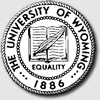
Wyoming Excellence in Higher Education Endowed Chair in Science Education
We are seeking a dynamic leader with knowledge of P-20 science education and the ability to engage multiple constituents. An earned doctorate with a well-established record of research including a history of extramural funding is expected. The candidates' research agendas should be relevant to P-20 education and demonstrate knowledge of cognition and student learning. Responsibilities include research, teaching in areas of expertise, and service/outreach on a state and national level.
This endowed chair will be a leader in the College of Education's focus to build on its existing programs in science education, teaching, outreach, and service, and the existing UW interdisciplinary strengths in science research, to cultivate a nationally recognized graduate program in science education. A complete description of this position can be found at http://ed.uwyo.edu.
Application: Applications should include a statement of research/ teaching interests/accomplishments, a vita, names/ contact information for 5 references. Send an electronic copy of the application materials to Ms. Debra Dobbyn at ddobbyn@uwyo.edu. Additional materials can be sent directly to Dr. Judith Ellsworth, Search Committee Chair, Dept. 3992, 1000 E. University Ave., Laramie, WY 82071. Applicant screening will begin on February 2, 2007.
The University of Wyoming is an Affirmative Action, Equal Opportunity employer.

|

Small Improvement in African-American College Graduation Rates, But the Large Racial Gap Persists
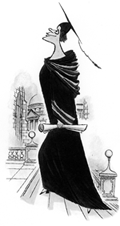 New data from the Department of Education shows that the nationwide college graduation rate for African Americans stands at an appallingly low rate of 43 percent. The graduation rate is computed by taking all students who enroll at a given institution and determining how many of these students received a bachelor’s degree from the same institution within a six-year period. New data from the Department of Education shows that the nationwide college graduation rate for African Americans stands at an appallingly low rate of 43 percent. The graduation rate is computed by taking all students who enroll at a given institution and determining how many of these students received a bachelor’s degree from the same institution within a six-year period.
When we break the figures down by gender, we see that the graduation rate for black women is 47 percent. For black men, the rate is a very low 36 percent.
But the good news is that the African-American college graduation rate is on the rise for both men and women. In 1990 the college graduation rate for black women was 34 percent. It has now increased 13 percentage points in the past 16 years. For black men, the college graduation rate in 1990 was 28 percent. Over the past 16 years the graduation rate for black men has increased by 8 percentage points.
Despite the increase in black student college graduation rates, the black-white graduation rate gap remains virtually unchanged. This year the white student college graduation rate is 63 percent. This is 20 percentage points higher than the rate for blacks.
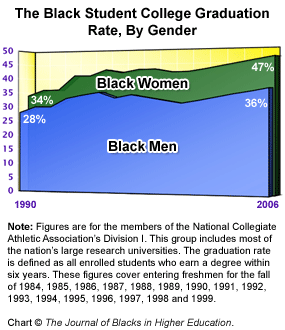
Occupational Status in 2003 of Blacks and Whites Who Graduated From College a Decade Earlier
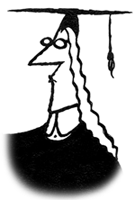 Last week JBHE reported the outcome of a new Department of Education study that examines the further educational progress of blacks and whites who completed their bachelor’s degree in the 1992-93 academic year. The study showed that for blacks, 45.5 percent of all college graduates had enrolled in an advanced degree program over the ensuing decade. For whites, the figure was 39.4 percent. Last week JBHE reported the outcome of a new Department of Education study that examines the further educational progress of blacks and whites who completed their bachelor’s degree in the 1992-93 academic year. The study showed that for blacks, 45.5 percent of all college graduates had enrolled in an advanced degree program over the ensuing decade. For whites, the figure was 39.4 percent.
Now, using data from the same study, we report on the occupational status in 2003 of blacks and whites who graduated with a four-year degree in the 1992-93 academic year.
The survey found that 10 years after completing their bachelor’s degrees, blacks were more likely to be employed than whites. Some 90 percent of all black bachelor’s degree holders were employed in 2003 compared to 87 percent of whites. Although about 69 percent of both black and white college graduates held full-time jobs, whites were more likely than blacks to hold a part-time job. But blacks were more likely than whites to hold two or more jobs.
Following historical patterns, blacks who earned a college degree in 1992-93 were nearly twice as likely as their white peers to be unemployed. The unemployment rate for black college graduates was 6.6 percent. For white college graduates, the rate was 3.5 percent.
Nearly 10 percent of whites with a bachelor’s degree were not in the labor force. This means that they were not working or looking for work. For blacks, only 3.4 percent of all 1992-93 college graduates were not in the labor force. Many of those not in the labor force are undoubtedly “stay-at-home moms.” A large number of women in the 1992-93 college graduating class are now in their prime child-bearing years and white women are more likely than black women to be able to afford to stop working in order to care for children.
Brown Is Not the Only Ivy League University With Historical Ties to Slavery
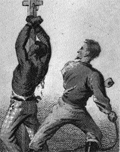 As noted in JBHE, Brown University recently released a comprehensive report on the institution’s historical ties to slavery. The Brown committee that issued the report offered several possible solutions as to how the university could atone for the fact that it benefited from the slave trade. As noted in JBHE, Brown University recently released a comprehensive report on the institution’s historical ties to slavery. The Brown committee that issued the report offered several possible solutions as to how the university could atone for the fact that it benefited from the slave trade.
Other Ivy League institutions also have historical connections to slavery. Harvard president Benjamin Wadsworth owned two house slaves whom he brought to Harvard when he was named president in 1725. Also, Isaac Royall, who provided funds for the establishment of Harvard Law School, was a plantation owner in Antigua. An endowed professorship at the law school still bears his name.
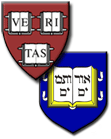 Yale, too, has its ties to slavery. Nine of the 12 residential colleges at Yale are named after slave owners or people who were strong advocates of slavery. One college is named after former Vice President of the United States John C. Calhoun of South Carolina. Calhoun was a fervent supporter of the institution of slavery. To this day, a stained glass window in the Calhoun College dining hall shows slaves working in the cotton fields. It also has been reported that Yale’s first endowed professorship, its first endowed scholarship, and the first endowed library fund were all donated by people with ties to slavery. Yale, too, has its ties to slavery. Nine of the 12 residential colleges at Yale are named after slave owners or people who were strong advocates of slavery. One college is named after former Vice President of the United States John C. Calhoun of South Carolina. Calhoun was a fervent supporter of the institution of slavery. To this day, a stained glass window in the Calhoun College dining hall shows slaves working in the cotton fields. It also has been reported that Yale’s first endowed professorship, its first endowed scholarship, and the first endowed library fund were all donated by people with ties to slavery.
The New Chancellor of North Carolina A&T State University
 Stanley F. Battle was named the new chancellor of North Carolina A&T State University. Lloyd V. Hackley, who was named interim chancellor when James Resnick left to take an executive position with the American Council on Education, will serve out the remainder of this academic year. Dr. Battle will assume his duties at North Carolina A&T on July 1, 2007. Stanley F. Battle was named the new chancellor of North Carolina A&T State University. Lloyd V. Hackley, who was named interim chancellor when James Resnick left to take an executive position with the American Council on Education, will serve out the remainder of this academic year. Dr. Battle will assume his duties at North Carolina A&T on July 1, 2007.
A native of Springfield, Massachusetts, Battle has served for the past three years as president of Coppin State University in Baltimore. He is a 1973 graduate of Springfield College, where he majored in sociology. Battle holds a master’s degree in social work from the University of Connecticut. He also holds a master’s degree in public health and a doctorate in social welfare policy from the University of Pittsburgh.
Prior to going to Coppin State, Dr. Battle taught at the University of Minnesota, Boston University, the University of Connecticut, Eastern Connecticut State University, and the University of Milwaukee at Wisconsin.

Ohio State University

Faculty Positions,
College of Education & Human Ecology
Department of Human Development & Family Science
The Ohio State University announces the opening of two 9 month, tenure track, open rank faculty positions in the Family Science and Child Development areas.
Requirements: Family Science: doctorate in Family Science or related area; research and teaching excellence in family and couple processes that contribute problematic behavior (violence, mental health, substance use, crime, obesity, sexual behavior, etc.). Child Development: doctorate in Child Development, Developmental Psychology or related area; research and teaching excellence related to the impact of environment, community, and family factors on the social or emotional development or adjustment of children. Salary commensurate with qualifications. For additional information about the college, department, or program areas, visit http://ehe.osu.edu/.
Submit letter of application, CV, and names of three (3) references to:
Natasha Slesnick, Chair, Search Committee
The Ohio State University
Department of Human Development & Family Science
1787 Neil Avenue
Columbus, OH 43210
Email: Slesnick.5@osu.edu
Telephone: (614-247-8469)
Evaluation will commence upon receipt of applications and continue until position is filled.
To build a diverse workforce, Ohio State encourages applications from minorities, veterans, women, and individuals with disabilities. EEO/AA employer.

Predominantly White College in Kentucky “Adopts” Black College Which Closed in 1988
In 1881 Bishop College was founded in Marshall, Texas, by the Baptist Home Mission Society. This historically black college was founded primarily for the purposes of “religious instruction” but offered courses in literature, science, and the arts. It was not until 1925 that Joseph J. Rhoads became the first African-American president of the college.
In 1961 Bishop College completed a move to a new campus in Dallas and emphasized a liberal arts education. Degrees were offered in 20 different fields. In the 1970s the college enrolled more than 1,200 students. But the school was always in financial difficulties and the president and two employees were charged with criminal embezzlement. By 1986 the college lost its accreditation and the next year filed for bankruptcy in an attempt to survive by restructuring its large debt load. This effort was unsuccessful and Bishop College closed in 1988. The campus was later bought by Paul Quinn College, a historically black institution which moved to Dallas from Waco.
 Now, Georgetown College, a Baptist-affiliated college in Kentucky where less than 4 percent of the students are black, has agreed to “adopt” Bishop College. Under the proposed adoption, Georgetown College will provide land on its campus for Bishop College alumni to erect a building that will be a replica of one on the Dallas campus. The building will be called the Bishop College Center for Academics. Classrooms will be named after faculty members who served at Bishop College. Homecoming events for Bishop College alumni will be held on the Georgetown College campus. African-American students at Georgetown College will be designated Bishop Scholars. Now, Georgetown College, a Baptist-affiliated college in Kentucky where less than 4 percent of the students are black, has agreed to “adopt” Bishop College. Under the proposed adoption, Georgetown College will provide land on its campus for Bishop College alumni to erect a building that will be a replica of one on the Dallas campus. The building will be called the Bishop College Center for Academics. Classrooms will be named after faculty members who served at Bishop College. Homecoming events for Bishop College alumni will be held on the Georgetown College campus. African-American students at Georgetown College will be designated Bishop Scholars.
The adoption of Bishop College will enable Georgetown College to claim Bishop alumni as its own. The addition of thousands of black alumni will help Georgetown College reach the minimum requirement for racial and ethnic diversity now required to become a member institution in the Phi Beta Kappa Society.
The Mentoring Kingpin of Higher Education in Science for African Americans
 Diola Bagayoko is a professor of physics at Southern University, the historically black educational institution in Baton Rouge, Louisiana. A native of Mali, Professor Bagayoko has developed a successful program to increase the number of black students studying in the natural sciences. Diola Bagayoko is a professor of physics at Southern University, the historically black educational institution in Baton Rouge, Louisiana. A native of Mali, Professor Bagayoko has developed a successful program to increase the number of black students studying in the natural sciences.
With grants from the National Science Foundation and the Defense Department’s Office of Naval Research, Professor Bagayoko established the Timbuktu Academy, a summer program in Baton Rouge for middle and high school students to prepare them for studying science in college. The program is open to students of all races but most applicants are from underrepresented minority groups, and a majority of students who attend the academy are African Americans.
The program has been highly successful. Of the 600 high school students who have participated, about 80 percent have gone on to major in science or mathematics in college. Of the 150 students who attended the academy and then enrolled at Southern University, more than 60 percent went on to graduate school to study science. For academy graduates who major in physics at Southern University and are under the direct tutelage of Professor Bagayoko, 90 percent have earned a bachelor’s degree in four years. The overall black student graduation rate at Southern University is 25 percent.
Black Voters Were Key to Reelection of the District Attorney Who Is Prosecuting Three White Students at Duke University for the Rape of a Black Woman
Mike Nifong won reelection as district attorney in Durham, North Carolina, despite the fact that a majority of voters preferred other candidates. Nifong has been severely criticized for his prosecution of three white Duke University students who he alleges raped a black woman from North Carolina Central University at a party held by the Duke lacrosse team. The woman had come to the party to perform as an exotic dancer. Despite the fact that no DNA evidence was found linking the three white students to the crime and that there was some conflicting testimony by the black student’s companion, the prosecution has proceeded.
Nifong won 80 percent of the vote in the city’s 13 predominantly black voting precincts. The 12 precincts in which Nifong received less than 35 percent of the total vote were all predominantly white.
The precinct in which many Duke students and faculty reside cast a majority of its votes for Nifong. At the precinct closest to the North Carolina Central University campus, 96 percent of the vote went to Nifong.

University of South Carolina
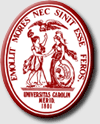
College of Social Work
Associate/Full Professor Position in Child and Family Studies
The University of South Carolina invites applications for a tenure-track faculty position at the rank of associate or full professor from candidates whose research programs focus on children, youth and families. The College of Social Work promotes social well-being and social justice of vulnerable populations through dynamic teaching, research, and service conducted in collaboration with diverse people of South Carolina, the nation, and the international community. The Colleges research programs include the Center for Child and Family Studies a partnership-oriented center focused on research and evaluation, education, and public service for children and families throughout the life course.
Responsibilities and Qualifications: Candidates for this position will be expected to maintain a strong program of collaborative research focused on the well-being of children, youth, and families. An earned doctorate in social work or related discipline is required. Qualifications must be commensurate with rank and include a record of leadership in collaborative extramural research, a publication record in high quality peer-reviewed journals, and a commitment to quality teaching. An MSW and two
years’ practice experience are highly desirable.
Salary: Highly competitive.
How to apply: Applicants should submit a letter of application, curriculum/research vita, and three letters of reference, one of which should be from a previous or current community or service agency partner. Additional materials that demonstrate educational, academic, and work experience should accompany the application package. Applications will be reviewed beginning December 1 and will be accepted until positions are filled.
For more information on this position, see http://cosw.sc.edu/.
USC is an equal employment opportunity institution.
Submissions should be addressed to:
College of Social Work Search Committee
c/o Dennis L. Poole, Dean
University of South Carolina
College of Social Work
Columbia, SC 29208

Grants
 • Chicago State University received a $1 million grant from the Walgreen Company for a program to support recruitment of more black and minority students to the university’s new College of Pharmacy which will open in the fall of 2008. Only 5 percent of all pharmacy school graduates in Illinois are black. • Chicago State University received a $1 million grant from the Walgreen Company for a program to support recruitment of more black and minority students to the university’s new College of Pharmacy which will open in the fall of 2008. Only 5 percent of all pharmacy school graduates in Illinois are black.
 • Miles College, the historically black educational institution in Fairfield, Alabama, received a four-year, $2.4 million grant from the National Science Foundation for a program to increase the number of black students in the natural sciences. The grant will fund the purchase of research equipment and enable the college to hold summer institutes for high school students interested in the study of science. • Miles College, the historically black educational institution in Fairfield, Alabama, received a four-year, $2.4 million grant from the National Science Foundation for a program to increase the number of black students in the natural sciences. The grant will fund the purchase of research equipment and enable the college to hold summer institutes for high school students interested in the study of science.
|
 .
.